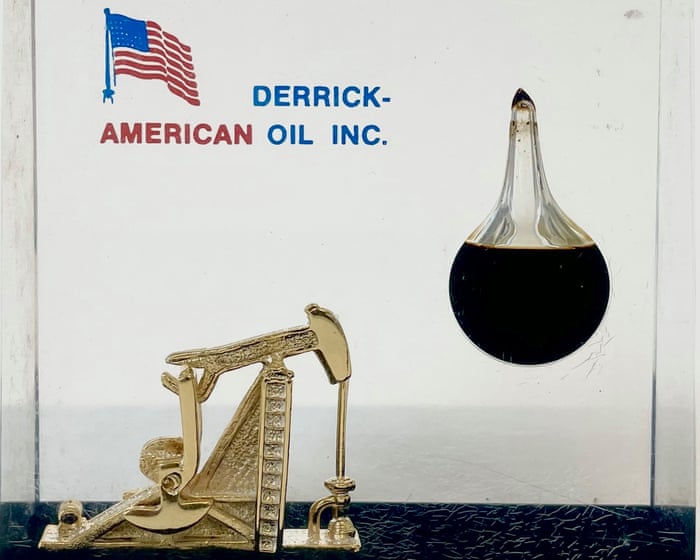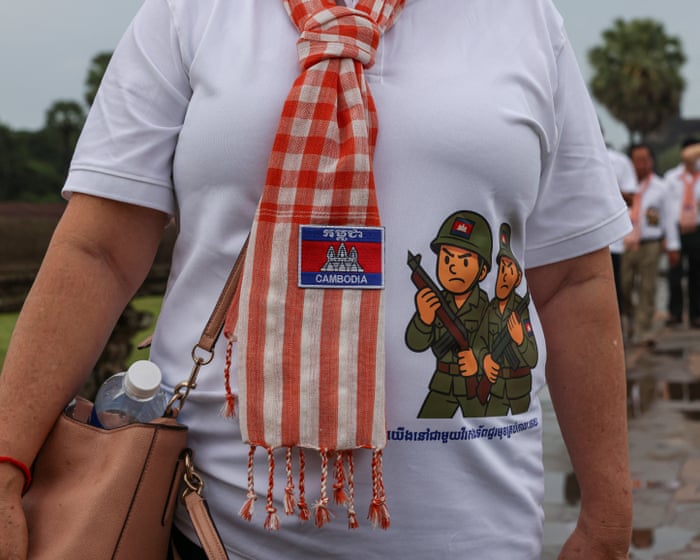In her bright Glasgow studio, artist Tanoa Sasraku shows me her collection of paperweights made by oil companies. “I find them so captivating, almost like perfume bottles or snow globes, yet so disturbing,” she says as we examine the engraved and sculpted pieces, each with a small drop of crude oil at its center. “They have these glossy, eye-catching surfaces, but up close you see the dark reality inside. All displays of power are fragile; they fall apart once you look closely.”
These paperweights are the centerpiece of Morale Patch, Sasraku’s upcoming solo exhibition at London’s ICA, which poetically explores oil’s role in geopolitics and national identity. Collected from oil-producing nations worldwide, the kitschy objects capture both the appeal of extraction and the arrogance and brittleness of the wealth and power it creates. Displayed on velvet-lined jewelry boards in a grid that maps global oil production—and the conflicts that follow—they resemble an absurd game of Battleships. “I was thinking about oil alliances, clashes between countries, and the stalemate that’s developed,” Sasraku notes. “When you plot them out, it feels like if one missile launched, everything would crumble.”
The work marks a seeming shift for the 29-year-old, Plymouth-born artist, known for tactile pieces using pigments from soil and ocean-soaked materials. But it grew from her ongoing interest in the storytelling power of organic substances—here, crude oil. “It’s death matter: the remains of marine life and prehistoric plants compressed underground,” Sasraku explains, “yet it bursts forth as a life force, driving human progress.” After visiting oil production sites in Scotland, where she moved from London in 2024, she wanted to handle the raw material. Surprisingly, it was easiest to find in tiny amounts inside paperweights commissioned by oil firms as corporate gifts.
Sasraku became fixated on gathering as many as she could. “I felt like I had to collect the world’s supply,” she laughs. “It became part of my daily routine to search eBay and get into bidding wars.” She recalls one intense but failed bid for a paperweight commemorating a Kylie Minogue concert in Aberdeen in the early 1990s—”such a strange blend of pop culture and Scottish industry.”
For the exhibition, she also commissioned custom paperweights from a Highlands company that makes corporate ones (which may have produced some in her collection). Some of these resemble military coffins draped with flags, their valuable contents not bodies but pen ink.
Wall-based works in the show reference flags too—fragile creations made from layered, soaked newsprint held together with bulldog clips. “The whole exhibition uses office ephemera,” she says. “I imagined politicians in their offices playing war games, toying with people’s lives.”
Morale Patch, through both found and created pieces, plays with a flashy design style inspired by Sasraku’s mixed feelings toward 1980s Americana. “The attitudes from that era—ambition, greed, masculinity—have really shaped today’s geopolitics,” she observes. “Look at Donald Trump. He has those broad, power-suited shoulders and talks like a jock from an ’80s movie.”
Symbols of American ambition fill her studio, where art supplies share space with cheerleaders’ pom-poms and vintage aspirational ads. This theme continues in an ongoing series…The designs draw from patterns in men’s clothing, influenced by both the bold silhouettes of power suits and the legacy of Sasraku’s father, the renowned Ghanaian fashion designer Kofi Ansah.
Creating this collection has led her to examine her connection with America’s “dominant culture.” As a child, American television shaped her speech, style, and even her food preferences. She recalls learning about 9/11 through footage of Michael Jackson watching the news—a moment where an iconic American figure intersected with an event that reshaped Western history. In her teens, she was drawn to the allure of an American lifestyle, but by 2025, that longing has faded. “My fascination with America remains, but my wish to be American has truly evolved.”
The ICA’s position on the Mall places Sasraku’s work near symbols of British national authority. “Yes, just a short distance from the historic seat of power,” she notes, referring to Buckingham Palace, “with the British flag recurring like a refrain. That proximity was very much part of the thinking.”
The themes in “Morale Patch” feel especially relevant now, and the creative process has been a release for the artist. “With nations like Britain, Israel, America, Russia, and Ukraine, we’re given reasons for their alliances,” Sasraku reflects. “But when you consider the oil and mineral resources that sustain these ties, they appear fragile. Understanding this has been clarifying, especially amid the UK’s complicity in widespread violence. Now the true motives behind it all are clear to me, and that’s freeing.”
Tanoa Sasraku: Morale Patch will be on display at the ICA in London from October 7 to January 11.
Frequently Asked Questions
Of course Here is a list of FAQs about the unsettling reality of the oil industry framed around the provocative statement Curious about the unsettling reality of the oil industry Just take a look at their cheap paperweights
FAQs The Unsettling Reality Behind Oil Industry Promotional Items
BeginnerLevel Questions
1 What does a cheap paperweight have to do with the oil industry
Its a metaphor These free promotional items are often given out to create a positive friendly image for a powerful industry distracting from its more controversial and harmful activities
2 What is the unsettling reality this refers to
It points to the negative impacts of the oil industry that are often hidden behind good PR such as environmental damage contribution to climate change political influence and human rights issues in some regions
3 Why would the oil industry give out free stuff
Its a form of marketing and public relations By giving you a useful little gift they aim to build goodwill and make you feel more positively toward their company making it harder to criticize their core business
4 Can you give a simple example of this unsettling reality
Yes A company might hand out a beautiful naturethemed calendar while simultaneously being responsible for a major oil spill that devastates a local ecosystem The calendar presents one image while their operations present another
Intermediate Practical Questions
5 What are some common paperweight tactics the industry uses
Beyond physical trinkets these tactics include
Greenwashing Using ecofriendly branding and ads while their primary business remains fossil fuels
Sponsorships Funding museums educational programs or sports events to associate their name with positive community values
Vague Climate Pledges Making promises for a cleaner future with distant deadlines and few concrete immediate actions
6 How does this PR strategy actually benefit the oil industry
It helps them maintain their social license to operate By managing public perception they can face less resistance to new drilling projects influence policymakers with a veneer of public support and attract young talent
7 What are the biggest environmental problems caused by the oil industry
The major issues are air and water




